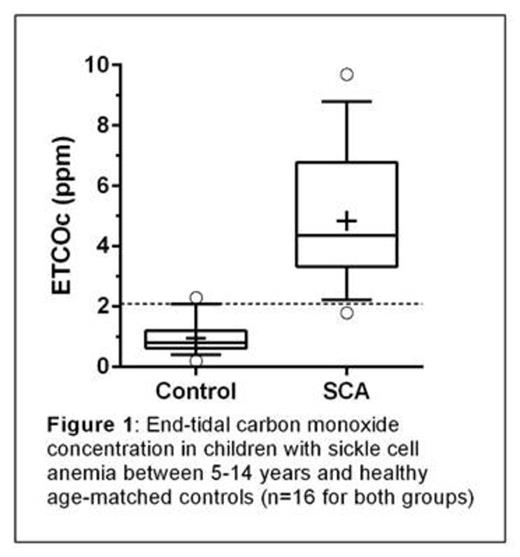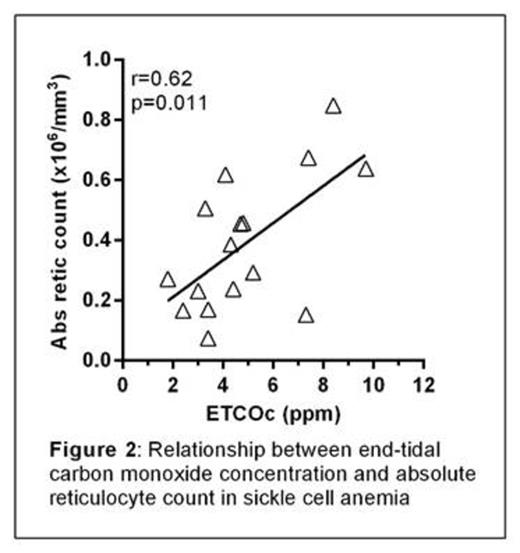Abstract
Background: Carbon monoxide (CO) produced during oxygen-dependent cleavage of porphyrin ring of heme is excreted in exhaled breath. The catabolism of heme is increased when red blood cells are destroyed at an accelerated rate. Thus, quantifying CO in exhaled breath could serve as an indicator of hemolysis. However, the requirement for forced breath sample has limited the measurement of exhaled CO in young children.
Objective: To assess end-tidal CO concentration (ETCOc) in children with sickle cell anemia (SCA).
Design/Methods: ETCOc was measured using the CoSense ETCO Monitor (Capnia Inc. Palo Alto, CA). Children between 5-14 years with SCA (Hb SS) who were not on chronic transfusions were eligible. Healthy children served as age-matched controls. Children with exposure to second-hand smoke, acute respiratory infection or symptomatic asthma were excluded. End-tidal breath samples were collected by placing the tip of a nasal cannula 5 mm into the nares. Up to 3 measurements were taken for each subject and the highest ETCOc value was used for analysis. (ClinicalTrials.gov: NCT01848691)
Results: The mean (range) age of 16 children with SCA and 16 controls was 9.7 years (5-14 years) and 9.9 years (5-14 years), respectively. The mean (± s.d.) ETCOc for SCA was 4.85 ± 2.24 ppm versus 0.96 ± 0.54 ppm for control group (p<0.001). The ETCOc in the control group ranged from 0.2 to 2.3 ppm, but was ≤1.2 ppm in 14/16, which is suggested as the upper limit of normal for healthy children. In the SCA group, the ETCOc range was 1.8 to 9.7 ppm, with values ≥2.4 ppm in 15/16 subjects. A threshold ETCOc value of >2.1 ppm provided both sensitivity and specificity equal to 93.8% (69.8-99.8%) for distinguishing SCA from healthy children. Children with SCA who had higher absolute reticulocyte count also demonstrated higher ETCOc (r=0.62, p=0.011). Patients with severe anemia (hemoglobin <8 g/dL) had a higher mean ETCOc (5.43 ppm) than the rest (4.40 ppm) but the difference was not significant. ETCOc level tended to increase with age in SCA (r=0.45, p=0.08).
Conclusions: Carbon monoxide in exhaled breath can be measured in young children in the clinic using a portable monitor. ETCOc may be a valuable tool for non-invasive monitoring of the severity of hemolysis in SCA. The mean ETCOc was 5-fold higher in SCA compared with controls, with little overlap seen between the groups. This suggests a potential use for ETCOc as a point-of-care screening test for SCA in children.
Lal:Capnia, Inc: Research Funding. Yen:Capnia, Inc. : Employment. Bhatnagar:Capnia, Inc: Employment.
Author notes
Asterisk with author names denotes non-ASH members.



